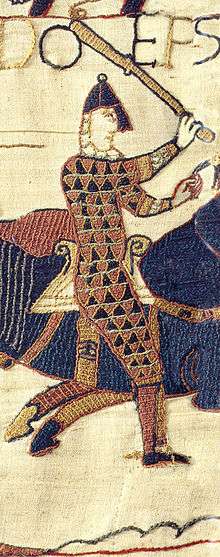Bayeux Tapestry tituli
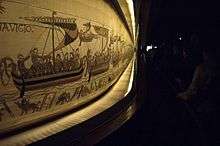
The Bayeux Tapestry tituli are captions embroidered on the Bayeux Tapestry describing events leading up to the Norman conquest of England concerning William, Duke of Normandy, and Harold, Earl of Wessex, later King of England, and culminating in the Battle of Hastings. The tituli are in Medieval Latin.
Description
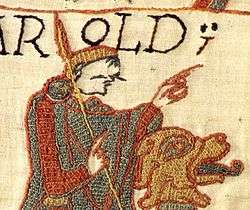
The Bayeux Tapestry was probably commissioned by William the Conqueror's half-brother, Bishop Odo, possibly at the same time as Bayeux Cathedral's construction in the 1070s, and completed by 1077 in time for display on the cathedral's dedication.[1] It is embroidered in wool yarn on a tabby-woven linen ground using outline or stem stitch for detailing and lettering.[2][3] A dark blue wool, almost black, is used for most of the tapestry's lettering but towards the end other colours are used, sometimes for each word and other times for each letter.
The content of the hanging is primarily pictorial but tituli are included on many scenes of the action to point out names of people and places or to explain briefly the event being depicted.[4] The text is in Latin (which for the most part is grammatically correct), and is extremely direct, with each statement being closely tied to the scenes depicted in a given section.[5][6] The text is frequently abbreviated as indicated by tildes placed over words at the place of omission of a letter. The words themselves are often demarcated by two points (which Lucien Musset likens to colons); sometimes, more important section breaks are demarcated by three points. Many personal names, mostly in English, are not Latinised and the same applies for names of places in England and for Beaurain "Belrem" in France. In places the spelling shows an English influence, such as the phrase "at Hestenga ceasrta", which in proper Latin would be "ad Hastingae castra").[5] Some French names are either archaic ("Rednes") or anglicised ("Bagias").[7] Sometimes "Franci" is used to describe the Normans who at that time certainly did not regard themselves as French.[8]
The end of the tapestry has been missing from time immemorial and the final titulus "Et fuga verterunt Angli" is said by Lucien Musset to be "entirely spurious", added shortly before 1814 at a time of anti-English sentiment.[9] The first word on the tapestry "Edward" is also a restoration.[10]
Latin text with English translation
The English translation provided here is of a literal nature, to reflect the simplicity of the captions themselves. The numbering scheme uses the scene numbers on the tapestry's backing cloth, which were added sometime around 1800.[4]
| Scene | Text[nb 1] | Translation[11] | Image |
|---|---|---|---|
| 1 | EDWARD[US][nb 2] REX | King Edward |  |
| 2-3 | UBI HAROLD DUX ANGLORUM ET SUI MILITES EQUITANT AD BOSHAM ECCLESIA[M] | Where Harold, duke of the English, and his knights ride to Bosham Church[12] |  |
| 4 | HIC HAROLD MARE NAVIGAVIT | Here Harold sailed by sea |  |
| 5 | ET VELIS VENTO PLENIS VENIT IN TERRA WIDONIS COMITIS | and with sails filled with wind came to the land of Count Wido[nb 3] | 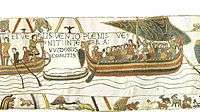 |
| 6 | HAROLD | Harold | 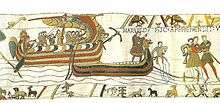 Higher resolution detail |
| 7 | HIC APPREHENDIT WIDO HAROLDU[M] | Here Wido seized Harold | 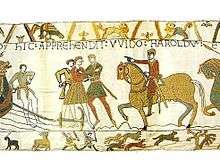 |
| 8 | ET DUXIT EUM AD BELREM ET IBI EUM TENUIT | and led him to Beaurain and held him there |  |
| 9 | UBI HAROLD ⁊[nb 4] WIDO PARABOLANT | Where Harold and Wido confer |  |
| 10 | UBI NUNTII WILLELMI DUCIS VENERUNT AD WIDONE[M] | Where the messengers of Duke William came to Wido |  |
| TUROLD | Turold[nb 5] | 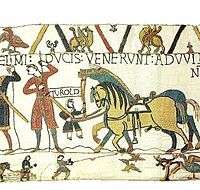 | |
| 11 | NUNTII WILLELMI | The messengers of William |  |
| 12 | HIC VENIT NUNTIUS AD WILGELMUM DUCEM | Here the messenger comes to Duke William | 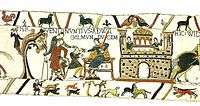 |
| 13 | HIC WIDO ADDUXIT HAROLDUM AD WILGELMUM NORMANNORUM DUCEM | Here Wido led Harold to William Duke of the Normans |  |
| 14 | HIC DUX WILGELM[US] CUM HAROLDO VENIT AD PALATIU[M] SUU[M] | Here Duke William comes with Harold to his palace |  |
| 15 | UBI UNUS CLERICUS ET ÆLFGYVA | Where a cleric and Ælfgyva ... [nb 6] |  Higher resolution detail |
| 16 | HIC WILLEM[US] DUX ET EXERCITUS EIUS VENERUNT AD MONTE[M] MICHAELIS | Here Duke William and his army came to the Mount of Michael |  |
| 17 | ET HIC TRANSIERUNT FLUMEN COSNONIS | and here they crossed the Couesnon River | 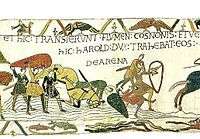 Higher resolution detail |
| HIC HAROLD DUX TRAHEBAT EOS DE ARENA | Here Duke Harold dragged them from the sand | ||
| 18 | ET VENERUNT AD DOL ET CONAN FUGA VERTIT | and they came to Dol and Conan turned in flight |  |
| REDNES | Rennes | 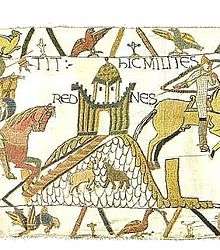 | |
| 19 | HIC MILITES WILLELMI DUCIS PUGNANT CONTRA DINANTES | Here the knights of Duke William fight against the men of Dinan |  Higher resolution detail |
| 20 | ET CUNAN CLAVES PORREXIT | and Conan passed out the keys | 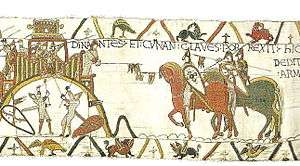 |
| 21 | HIC WILLELM[US] DEDIT ARMA HAROLDO | Here William gave arms to Harold | 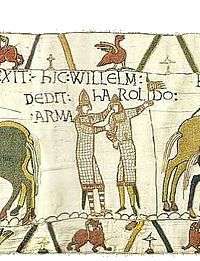 |
| 22 | HIE [sic][nb 7] WILLELM[US] VENIT BAGIAS | Here William came to Bayeux | 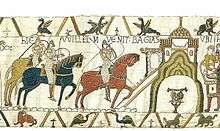 |
| 23 | UBI HAROLD SACRAMENTUM FECIT WILLELMO DUCI | Where Harold made an oath to Duke William | 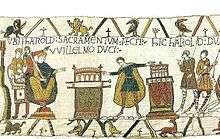 |
| 24 | HIC HAROLD DUX REVERSUS EST AD ANGLICAM TERRAM | Here Duke Harold returned to English land |  |
| 25 | ET VENIT AD EDWARDU[M] REGEM | and he came to King Edward | 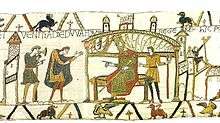 |
| 26 | HIC PORTATUR CORPUS EADWARDI REGIS AD ECCLESIAM S[AN]C[T]I PETRI AP[OSTO]LI | Here the body of King Edward is carried to the Church of Saint Peter the Apostle[nb 8] |  |
| 27 | HIC EADWARDUS REX IN LECTO ALLOQUIT[UR] FIDELES | Here King Edward in bed speaks to his faithful followers | 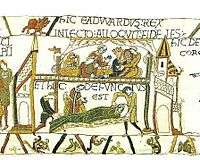 Higher resolution detail |
| 28 | ET HIC DEFUNCTUS EST | and here he died | |
| 29 | HIC DEDERUNT HAROLDO CORONA[M] REGIS | Here they gave the king's crown to Harold |  |
| 30 | HIC RESIDET HAROLD REX ANGLORUM | Here sits Harold King of the English | 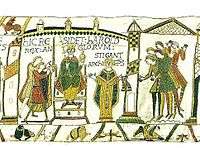 Higher resolution detail |
| 31 | STIGANT ARCHIEP[ISCOPU]S | Archbishop Stigand | |
| 32 | ISTI MIRANT[UR] STELLA[M] | These people marvel at the star[nb 9] |  |
| 33 | HAROLD | Harold |  |
| 34 | HIC NAVIS ANGLICA VENIT IN TERRAM WILLELMI DUCIS | Here an English ship came to the land of Duke William |  |
| 35 | HIC WILLELM[US] DUX JUSSIT NAVES [A]EDIFICARE | Here Duke William ordered ships to be built |  |
| 36 | HIC TRAHUNT NAVES AD MARE | Here they drag the ships to the sea |  |
| 37 | ISTI PORTANT ARMAS AD NAVES ET HIC TRAHUNT CARRUM CUM VINO ET ARMIS | These men carry arms to the ships and here they drag a cart (laden) with wine and arms |  |
| 38 | HIC WILLELM[US] DUX IN MAGNO NAVIGIO MARE TRANSIVIT ET VENIT AD PEVENESÆ | Here Duke William in a great ship crossed the sea and came to Pevensey | |
| 39 | HIC EXEUNT CABALLI DE NAVIBUS | Here the horses leave the ships |  |
| 40 | ET HIC MILITES FESTINAVERUNT HESTINGA UT CIBUM RAPERENTUR | and here the knights have hurried to Hastings to seize food |  Higher resolution detail |
| 41 | HIC EST WADARD | Here is Wadard[nb 10] | 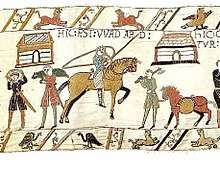 |
| 42 | HIC COQUITUR CARO ET HIC MINISTRAVERUNT MINISTRI | Here the meat is being cooked and here the servants have served (it) | 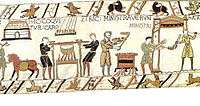 |
| 43 | HIC FECERUN[T] PRANDIUM | Here they have a meal | 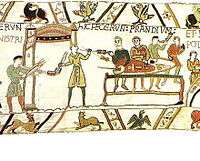 |
| HIC EPISCOPUS CIBU[M] ET POTU[M] BENEDICIT | Here the bishop blesses the food and drink | 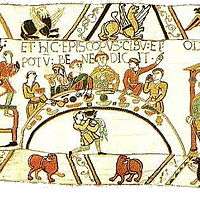 Higher resolution detail | |
| 44 | ODO EP[ISCOPU]S WILLEM[US] ROTBERT | Bishop Odo, William, Robert |  |
| 45 | ISTE JUSSIT UT FODERETUR CASTELLUM AT HESTENGA[nb 11] | He ordered that a motte should be dug at Hastings | 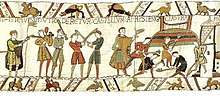 Higher resolution detail |
| CEASTRA[nb 12] | the camp | ||
| 46 | HIC NUNTIATUM EST WILLELM[O] DE HAROLD[O] | Here William was told about Harold |  |
| 47 | HIC DOMUS INCENDITUR | Here a house is burned |  |
| 48 | HIC MILITES EXIERUNT DE HESTENGA ET VENERUNT AD PR[O]ELIUM CONTRA HAROLDUM REGE[M] | Here the knights have left Hastings and have come to the battle against King Harold | Higher resolution detail |
| 49 | HIC WILLELM[US] DUX INTERROGAT VITAL[EM] SI VIDISSET HAROLDI EXERCITU[M] | Here Duke William asks Vital[nb 13] if he has seen Harold's army |  |
| 50 | ISTE NUNTIAT HAROLDUM REGE[M] DE EXERCITU WILLELMI DUCIS | This man tells King Harold about Duke William's army | 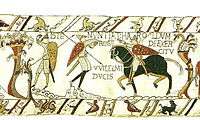 |
| 51 | HIC WILLELM[US] DUX ALLOQUITUR SUIS MILITIBUS UT PREPAREN[T] SE VIRILITER ET SAPIENTER AD PR[O]ELIUM CONTRA ANGLORUM EXERCITU[M] | Here Duke William speaks to[nb 14] his knights to prepare themselves manfully and wisely for the battle against the army of the English |   |
| 52 | HIC CECIDERUNT LEWINE ET GYRD FRATRES HAROLDI REGIS | Here fell Leofwine and Gyrth, brothers of King Harold |   |
| 53 | HIC CECIDERUNT SIMUL ANGLI ET FRANCI IN PR[O]ELIO | Here English and French fell at the same time in battle |  Higher resolution detail |
| 54 | HIC ODO EP[ISCOPU]S BACULU[M] TENENS CONFORTAT PUEROS | Here Bishop Odo, holding a club, gives strength to the boys |  |
| 55 | HIC EST WILLEL[MUS] DUX | Here is Duke William |  |
| 56 | E[USTA]TIUS | Eustace | 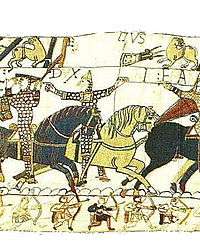 Higher resolution detail |
| HIC FRANCI PUGNANT ET CECIDERUNT QUI ERANT CUM HAROLDO | Here the French are fighting and have killed those who were with Harold | ||
| 57 | HIC HAROLD REX INTERFECTUS EST | Here King Harold is slain |  Higher resolution detail |
| 58 | ET FUGA VERTERUNT ANGLI[nb 15] | and the English have turned in flight |  Higher resolution detail |
Notes
- ↑ Letters in square brackets are omitted on the tapestry either by way of abbreviation or where they are implied by a macron diacritic on the previous letter.
- ↑ The Bayeux Tapestry scholar Lucien Musset argues that "Edward" is anachronistic (as his name is spelled elsewhere on the tapestry as "Eadwardus") and that it was almost certainly added by restorers, given that the name is missing in 18th century copies.[10]
- ↑ Wido is Guido or Guy, count of Ponthieu.[13]
- ↑ This symbol, resembling a right-angled 7, is a Tironian note abbreviation for et ("and").[5]
- ↑ Possibly a member of either or Duke William or Bishop Odo's entourage.[14]
- ↑ A verb is missing, which makes this image the greatest mystery in the Tapestry. The historian D. C. Douglas commented as follows: "The similarity of attitude between the clerk and the semi-obscene figure in the lower margin will not escape notice, nor will the absence of a verb in the legend. Perhaps the dovecot and the doves in the upper border have an erotic significance, and the whole episode may possibly refer to some scandal, then notorious, but now advantageously forgotten".[15] Theories on the woman and her relationship with the cleric abound, ranging from being an embroidress to receiving anger, lewdness or affection on part of the clergyman.[16]
- ↑ This word is a miss-spelling of the demonstrative pronoun hic.[17][18]
- ↑ I.e. Westminster Abbey.[19]
- ↑ I.e. Halley's comet.[20]
- ↑ A vassal of Bishop Odo.[21]
- ↑ The spelling of the Latin word ad here has been cited by some in favour of the theory that the Tapestry was made in England.[22]
- ↑ The spelling of the Latin word castra here has been cited by some in favour of the theory that the Tapestry was made in England.[22]
- ↑ Possibly a vassal of Bishop Odo.[23]
- ↑ Or "harangues".[24]
- ↑ This caption was missing in 18th century copies. Musset refers to this line as "entirely spurious" and the result of "heavy-handed restoration".[9]
References
Citations
- ↑ Stenton (1961).
- ↑ Coatsworth (2005), p. 23.
- ↑ Musset (2011), p. 19.
- 1 2 Musset (2011).
- 1 2 3 Musset (2011), p. 35.
- ↑ Musset (2011), p. 36.
- ↑ Musset (2011), pp. 35–6.
- ↑ Musset (2011), p. 37.
- 1 2 Musset (2011), p. 266.
- 1 2 Musset (2011), p. 88.
- ↑ Translations based mainly on Stenton (1965), Hicks (2006), Musset (2002), p. 270; and Musset (2011), pp. 266, 270.
- ↑ Integral scene per Douglas (1961), p. 233.
- ↑ Musset (2011), p. 104.
- ↑ Musset (2011), p. 112.
- ↑ Douglas (1961), p. 234, plate XVIII
- ↑ "Aelfgyva: The Mysterious Lady of the Bayeux Tapestry". Medievalists.net. August 24, 2014. Archived from the original on April 13, 2017. Retrieved April 12, 2017.
- ↑ Musset (2011), p. 114.
- ↑ Walls (1962), p. 3. "Some inconsistencies of orthography can be accounted for as slips of the needle [...] for example, 'hie' for 'hic'".
- ↑ Jenkyns (2011), p. 130.
- ↑ Olson & Pasachoff (1987), p. 2.
- ↑ Musset (2011), p. 208.
- 1 2 Douglas (1961) p. 237.
- ↑ Musset (2011), p. 224.
- ↑ Plaché (1867), p. 151.
Sources
- Coatsworth, Elizabeth (2005). "Stitches in Time: Establishing a History of Anglo-Saxon Embroidery". In Netherton, Robin; Owen-Crocker, Gale R. Medieval Clothing and Textiles. 1. Suffolk, UK: Boydell & Brewer. pp. 1–27.
- Douglas, D.C., ed. (1961). "Bayeux Tapestry". English Historical Documents 1042–1189. London: Eyre & Spottiswoode. pp. 232–78.
- Hicks, Carola (2006). The Bayeux Tapestry: The Life Story of a Masterpiece. London, UK: Vintage Books. ISBN 9781407065885.
- Jenkyns, Richard (2011). Westminster Abbey: A Thousand Years of National Pageantry. London, UK: Profile Books. ISBN 9781847650825.
- Musset, Lucien (2002). La Tapisserie de Bayeux (in French). Paris, France: Éditions Zodiaque. ISBN 9782736902810.
- Musset, Lucien (2011). The Bayeux Tapestry. Translated by Rex, Richard. Suffolk, UK: Boydell & Brewer. ISBN 9781843831631.
- Olson, J. M.; Pasachoff, M. (1987). "New Information on Comet P/Halley as Depicted by Giotto di Bondone and Other Western Artists". Astronomy and Astrophysics (187): 1–11.
- Plaché, J. R. (1867). "On the Bayeux Tapestry". Journal of the British Archaeological Association. 23: 134–56.
- Stenton, Frank (1965). The Bayeux Tapestry. Phaedon Press.
- Walls, Sidney (1962). "The Bayeux Tapestry: Its Sources and Influence". Scripta Humanistica Kentuckiensia. 6. Retrieved October 20, 2017 – via the University of Florida Libraries.
